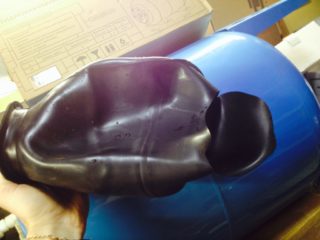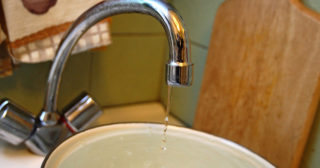The membrane in the accumulator helps to maintain the required water pressure. It allows to mitigate water hammer and prolongs the life of the pumping station. But the elastic part deteriorates over time. The situation can be corrected by repairing or completely replacing the rubber element.
Features of accumulator membranes

A rubber diaphragm divides the tank into two compartments - air and water. The space between the diaphragm surface and the body of the hydraulic accumulator is filled with high pressure air. Thanks to this, water flows to the point of consumption through the water supply system under the required pressure.
Diaphragms can be flat and balloon-like, they can be in the form of a heating pad in tanks up to 100 liters, pears or bottles in large tanks.
White membranes made of natural or bottled rubber are used in hydraulic tanks intended for drinking water supply. Black made of EPDM or SBR rubber, resistant to temperature changes - for heating systems. The former are inferior in resistance to an increase in temperature and pressure, but are not afraid of pathogenic microorganisms.
Manufacturers produce two types of expansion membrane devices - with a removable and a stationary membrane. The former are more expensive, but they allow you to change the part when gaps and deformation appear. The latter are cheaper. But in this case, there is no possibility of replacing damaged elements. The entire device will become unusable if the diaphragm is damaged.
When choosing a new membrane, you need to pay attention not only to the color or composition of the material. The part must be tight, strong, and free from signs of cracks. It must correspond in volume, length and size to the neck of the hydraulic tank. It is recommended to buy components of the same brand as the main unit, since spare parts from different manufacturers may differ significantly.
The main causes of wear
Factors that negatively affect the state of the membrane:
- continuous compression and stretching;
- pressure and temperature drops and an increase in these indicators above the standards;
- friction of the diaphragm against the walls of the apparatus body.
The operating conditions in water supply systems and heating networks are such that it is simply impossible to avoid negative effects. Diaphragm manufacturers provide a five-year warranty on diaphragm performance. But in fact, they have to be replaced more often. With constant use of the hydraulic tank, a pear usually lasts no more than three years, and in harsh conditions - about a year. In order to detect the problem in time, it is recommended to carry out a preventive examination of this node every six months.
Signs of need for replacement or repair

The failure of the membrane element is indicated by the following malfunctions:
- the pressure device is often turned on and off;
- the hydraulic tank works in jerks;
- nipple leaks;
- pressure gauge readings start up rapidly, and then drop sharply;
- the flow from the tap flows out intermittently;
- there is a leak behind the air valve.
Diagnosis is necessary to confirm diaphragm damage, as these same signs can indicate cracks in the battery housing.
Compliance is checked by disconnecting the hydraulic tank from the water supply system and then draining the remaining water in it.If air escapes with the liquid, it means that mechanical damage is present on the rubber part. The same means if the nipple starts to leak when the air is released. Therefore, it is necessary to change or repair the membrane in the accumulator with your own hands, which, in principle, is not difficult.
A loose connection between the battery housing and the flange union can also cause malfunctions.
When using equipment without water supply, the diaphragm can be pressed against the inlet fitting by pressure. Because of this, the liquid does not enter the accumulator through the supply pipeline. To solve the problem, you need to unscrew the flange and straighten the membrane, at the same time checking it for damage.
If the cause of the failures was cracks in the body of the hydraulic tank, it makes no sense to tinker with the membrane. If the damage is small, it can be repaired by cold welding. In case of serious defects, you will need to buy a new device.
Diaphragm repair
Repair of the accumulator membrane is possible if the damage is minor. This is especially true in units with fixed diaphragms. After all, there, when the rubber part is worn out, the entire apparatus will have to be changed.
A very tiny crack is sealed using a rubber adhesive.
You can repair the part yourself using a vulcanizer for bicycle or car cameras. A similar problem is addressed to the tire service. Before installing a repaired diaphragm, you must carefully check the inside of the drive. No protrusions or burrs are allowed.
Repair work will extend the life of the membrane, but not for long, on average - by six months. After that, you still have to buy a new one.
Stages of installing a new part

The problem of replacing the accumulator membrane arises quite often. It's good that this process is extremely simple, you can do it yourself, without the involvement of professionals. And the price of the components is relatively low - from 200 rubles, depending on the volume.
First, it is necessary to check the compliance of the new membrane with the volume and other parameters of the battery. If all indicators match, you need to disassemble the drive. Before replacing a worn-out bulb in the accumulator, you need to relieve the pressure in it, blocking the flow of water and draining the residues, then disconnect from the power supply.
To change the diaphragm, you need to proceed as follows:
- Loosen the fixing bolts of the flanges and remove them.
- Remove the damaged part through the special hole on the bottom of the tank.
- Examine the diaphragm and assess the extent of the damage - suddenly it can be repaired.
- Clean the tank itself from corrosion and deposits, and the flange from any burrs.
- Take the holder and insert it into the hole that is on top of the diaphragm.
- Place the membrane in the hydraulic tank, and, screwing the bolt into the holder, insert it into the opening located in the bottom of the case.
- Spread out the throat and tighten with the flange, tightening the bolts from opposite sides.
After assembling the device in the reverse order, pump air into the hydraulic tank. This will allow the appliance to function properly. Pumping is carried out using a conventional pumping device through a spool located at the bottom of the body part.
Then there is a connection to the water supply and electrical network and the operation of the equipment is checked. Water must be connected gradually so as not to provoke a rupture of a new diaphragm.
In order for problems with the membrane part to arise as rarely as possible, it is necessary to provide a comfortable operating environment for the device. In particular, make sure that there are no pressure drops and temperature jumps in the hydraulic tank, and regularly carry out preventive examinations. When the device is not in use, it is stored in a dry place, away from heating devices, so that the rubber of the diaphragm does not dry out or crack.








